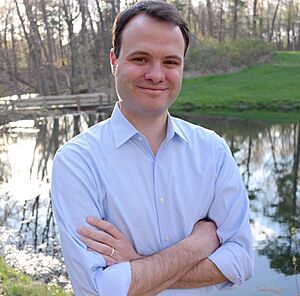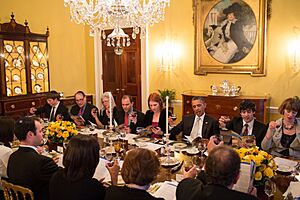White House Passover Seder facts for kids
The White House Passover Seder was a special yearly dinner. It took place at the White House during the Jewish holiday of Passover. Barack Obama, when he was president, started this tradition in 2009. He invited his family, staff, and friends. At the dinner, they read from the Haggadah, a special book. They talked about the meaning of Passover and how it related to current events. They also shared a holiday meal. President Obama hosted this Seder every year from 2009 to 2016. It was the first time a U.S. president held a Passover Seder inside the White House.
Contents
What is a Passover Seder?
A Passover Seder is a special meal. Jewish people hold it on the first one or two nights of the Passover holiday. Families usually have the Seder at home with guests. But any group of Jewish people can hold one. This includes groups at a synagogue or a school.
During the Seder, people read from the Haggadah. This book tells the story of the Israelites. It explains how they became free from slavery in ancient Egypt. Special foods on the Seder Plate help tell the story. A big, festive meal is also part of the Seder.
How the White House Seder Started
The White House Passover Seder began in a simple way. It started on April 19, 2008. Three young staff members from Barack Obama's campaign held an informal Seder. At that time, Obama was running for president. His team was in Harrisburg, Pennsylvania. The Jewish staff members knew they could not go home for Passover.
These three staffers were Eric Lesser, Herbie Ziskend, and Arun Chaudhary. They got a "Passover kit" with wine, matzo, and Haggadahs. They were having their Seder in a hotel meeting room. Then, Obama walked in. "Hey, is this the Seder?" he asked. He and other aides, who were not Jewish, joined in. Obama already knew about the Seder. He had attended Passover Seders for nine years. At the end, they said the traditional wish, "Next year in Jerusalem." Obama added, "Next year in the White House."
The next year, Obama was president. His junior staffers were working at the White House. Obama told them to hold the Seder again. The 2009 event was the first time a U.S. president held a Passover Seder in the White House. Many people called the White House wanting an invitation.
The White House Seder was held on the second night of Passover. This let Jewish staff spend the first night with their families. About 20 guests sat around a table. They were in the Old Family Dining Room. They read the Haggadah and ate traditional Seder foods. Malia and Sasha Obama were the youngest. They asked the Four Questions. They also looked for the afikoman, a hidden piece of matzo.
President Obama hosted the Seder every year of his eight years in office. Some traditions included Obama pretending to be Pharaoh. Chaudhary gave a speech about the Hillel sandwich. A Secret Service member watched over the hidden afikoman. The Seder took place in the Old Family Dining Room. It lasted for two hours. In 2016, Obama's last year, the Seder was on April 26. This was because he had a trip to Saudi Arabia planned earlier.
Meaning and Themes of the Seder
In 2013, Obama visited Israel. He said he brought the Seder to the White House. He wanted his daughters to learn the story of the Exodus. He felt the story's ideas were important to him. He explained: "For African Americans, the Exodus story was very powerful. It showed how people could escape slavery and find freedom. This idea carried through the Civil Rights Movement. For me, growing up in different places, the story spoke to a wish for a home."
Many guests at the White House Seder were African American. They saw links between the Israelites' Exodus from Egypt and the American civil rights movement. Ideas like social justice, struggle, and freedom were often discussed. When the prophet Elijah is welcomed, guests recited the Emancipation Proclamation.
Even the serving dishes had meaning. In 2009, they used silverware from the Truman administration. Truman was the first president to recognize Israel. In 2013, Israel's First Lady Sara Netanyahu gave a Seder Plate as a gift. This plate was used every year. Everyone read from the Maxwell House Haggadah. This book is very common in Jewish homes.
White House Seder Menu
The food at the White House Passover Seder was traditional. It included American Jewish Passover dishes. Some foods were gefilte fish, charoset, and chicken soup with matzah balls. They also had brisket, potato kugel, and macaroons. Salads and vegetable dishes were also served.
Eric Lesser brought special shmurah matzah. It came from a Jewish center in Springfield, Massachusetts. Family recipes were important. In 2015, they used matzo ball soup from Ziskend's grandmother. Lesser's mother's carrot soufflé was also served. Chaudhary's mother' made Raspberry Ganache Marjolaine. The recipes came from both Ashkenazic and Sephardic traditions. The food was not strictly kosher, but it was "kosher style." In 2014, a guest chef started helping with the menu. They worked with the White House executive chef.
Who Attended the Seder?
The White House Passover Seder was not a political event. It was different from the White House Hanukkah Party. The guest list did not include rabbis, Jewish lobbyists, or members of Congress. There were also no Israeli representatives. The guest list stayed mostly the same each year. About 20 people attended.
Guests included the president and his family. Staff members from the president and first lady also came with their families. Friends of the Obamas were also invited. The group was a mix of Jewish and non-Jewish people.
Other Seders at the White House
In April 1993, staff members of President Clinton held a Passover Seder. It was in the Indian Treaty Room. President Clinton was not there.
On April 10, 2017, some staff from the Trump Administration held a Seder. It was in the Eisenhower Executive Office Building. But unlike during Obama's time, President Trump and his family did not attend.






